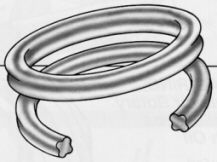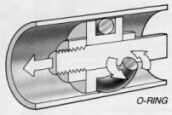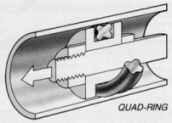
The four-lobed design provides twice the sealing surface of a comparable standard o-ring and because of this double-seal action, less squeeze is required to maintain an effective seal. This reduction in squeeze means less friction and therefore, improved seal life.
Unlike o-rings, where parting lines are on the sealing surface, QUAD-RING
seals' parting lines lie between the lobes, away from the sealing surface. This
design eliminates the problems of leakage often resulting from a parting line's
irregular surface.
QUAD-RING seals can be used as compression-type seals
in high speed rotary applications, eliminating the need for costlier
spring-loaded seals. They offer low friction for long life in hydraulic systems
with speeds of up to 900 FPM (4.5 M/Sec).

